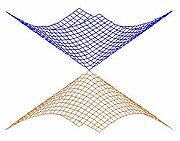
Conical intersection
Encyclopedia

Quantum chemistry
Quantum chemistry is a branch of chemistry whose primary focus is the application of quantum mechanics in physical models and experiments of chemical systems...
, a conical intersection of two potential energy surface
Potential energy surface
A potential energy surface is generally used within the adiabatic or Born–Oppenheimer approximation in quantum mechanics and statistical mechanics to model chemical reactions and interactions in simple chemical and physical systems...
s of the same spatial and spin symmetries is the set of molecular geometry
Molecular geometry
Molecular geometry or molecular structure is the three-dimensional arrangement of the atoms that constitute a molecule. It determines several properties of a substance including its reactivity, polarity, phase of matter, color, magnetism, and biological activity.- Molecular geometry determination...
points where the two potential energy surface
Potential energy surface
A potential energy surface is generally used within the adiabatic or Born–Oppenheimer approximation in quantum mechanics and statistical mechanics to model chemical reactions and interactions in simple chemical and physical systems...
s are degenerate (intersect). Conical intersections are ubiquitous in both trivial and non-trivial chemical systems.
In a two coordinate system, this can occur at one molecular geometry
Molecular geometry
Molecular geometry or molecular structure is the three-dimensional arrangement of the atoms that constitute a molecule. It determines several properties of a substance including its reactivity, polarity, phase of matter, color, magnetism, and biological activity.- Molecular geometry determination...
. If the potential energy surfaces are plotted as functions of the two coordinates, they form a cone
Cone (geometry)
A cone is an n-dimensional geometric shape that tapers smoothly from a base to a point called the apex or vertex. Formally, it is the solid figure formed by the locus of all straight line segments that join the apex to the base...
centered at the degeneracy point. This is shown in the picture on the right, where the upper and lower potential energy surfaces are plotted in different colors. The name conical intersection comes from this observation.
In a system with n coordinates, degenerate points lie in what is called the intersection space, or seam
Seam
Seam may refer to:* Seam , the line where two or more layers of fabric are held together by stitches* Seam , a stratum of coal or mineral that is economically viable; a bed or a distinct layer of vein of rock in other layers of rock...
. The dimensionality of the seam is n-2. For a conical intersection, the remaining two dimensions that lift the energetic degeneracy of the system are known as the branching space.
The conical intersections are also called molecular funnels or diabolic points. This comes from the very important role they play in non-radiative de-excitation transitions from excited electronic states to the ground electronic state of molecules. For example, the stability of DNA
DNA
Deoxyribonucleic acid is a nucleic acid that contains the genetic instructions used in the development and functioning of all known living organisms . The DNA segments that carry this genetic information are called genes, but other DNA sequences have structural purposes, or are involved in...
with respect to the UV irradiation is due to such conical intersection. The molecular wave packet
Wave packet
In physics, a wave packet is a short "burst" or "envelope" of wave action that travels as a unit. A wave packet can be analyzed into, or can be synthesized from, an infinite set of component sinusoidal waves of different wavenumbers, with phases and amplitudes such that they interfere...
excited to some electronic excited state
Excited state
Excitation is an elevation in energy level above an arbitrary baseline energy state. In physics there is a specific technical definition for energy level which is often associated with an atom being excited to an excited state....
by the UV photon
Photon
In physics, a photon is an elementary particle, the quantum of the electromagnetic interaction and the basic unit of light and all other forms of electromagnetic radiation. It is also the force carrier for the electromagnetic force...
follows the slope of the potential energy surface
Potential energy surface
A potential energy surface is generally used within the adiabatic or Born–Oppenheimer approximation in quantum mechanics and statistical mechanics to model chemical reactions and interactions in simple chemical and physical systems...
and reaches the conical intersection from above. At this point the very large vibronic coupling
Vibronic coupling
In theoretical chemistry, the vibronic coupling terms, , are proportional to the interaction between electronic and nuclear motions of molecules. The term "vibronic" originates from the concatenation of the terms "vibrational" and "electronic"...
induces a non-radiative transition (surface-hopping) which leads the molecule back to its electronic ground state
Ground state
The ground state of a quantum mechanical system is its lowest-energy state; the energy of the ground state is known as the zero-point energy of the system. An excited state is any state with energy greater than the ground state...
.
A well-written introduction to the topic of conical intersections in chemistry is Diabolical Conical Intersections, David Yarkony, Rev. Mod. Phys. 68, 985-1013 (1996).
A clear authoritative book on the intricate mathematical aspects of conical intersections can be found in Beyond Born-Oppenheimer: Electronic Nonadiabatic Coupling Terms and Conical Intersections by Michael Baer (Wiley-Interscience, 2006).

